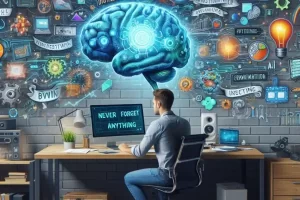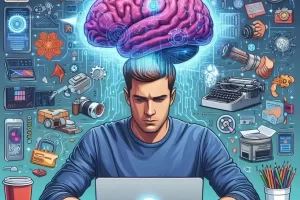Time management is essential — but energy management is what truly sustains high performance, creativity, and well-being. You can have the perfect calendar, but if you’re exhausted, distracted, or burned out, even simple tasks feel overwhelming. That’s where your second brain, supported by artificial intelligence (AI), comes in: to help you track, understand, and optimize your energy across days, weeks, and seasons.
In this article, you’ll learn how to use your second brain and AI to create an energy-aware productivity system that works with your natural rhythms — not against them.
Why Energy Management Matters More Than Time
You can’t control how many hours are in a day, but you can control:
- When you do your most important work
- What activities drain or recharge you
- How you schedule recovery and deep work
- Which routines support your physical and mental energy
- How aligned your work is with your internal motivation
Without energy management:
- You burn out or get stuck in low-efficiency output
- You overcommit and underperform
- Your performance varies wildly day to day
- You can’t focus when it matters most
With a second brain and AI, you create a system that optimizes your peak states.
Create an Energy Log in Your Second Brain
Start tracking how you feel each day — not just what you did.
Track in your daily or weekly journal:
- 🧠 Mental clarity
- 💪 Physical energy
- ❤️ Emotional state
- ☕ Sleep quality and caffeine use
- 🔋 Energy triggers and drains
- 🗓 Time of peak flow or slumps
Let AI assist:
“Summarize my energy levels for the past 7 days.”
“What patterns do you notice between my mood, sleep, and focus?”
“Which activities consistently recharge me?”
This builds awareness — the first step to energy mastery.
Identify Your Personal Energy Patterns
Everyone has a unique rhythm. Some peak in the morning, others at night. Use your second brain and AI to identify:
- Your chronotype (early bird, night owl, etc.)
- Your best time for deep work
- Your worst time for focus
- Patterns of energy crashes
- Impact of nutrition, sleep, exercise, or meetings
Ask AI:
“When do I do my best work based on the last month’s data?”
“How does my energy fluctuate during the week?”
“What factors increase or decrease my energy the most?”
Now you can plan around energy, not just availability.
Design a Weekly Energy Map
Use your second brain to create a visual of how your energy flows across the week.
Include:
- 🔁 Recurring low-energy periods
- 🌟 High-focus blocks
- ⛔ Non-negotiable rest/recovery times
- 🧘 Activities that support emotional and physical recharge
- 🧩 Ideal times for certain task types (meetings, creative work, admin)
Use AI to:
“Generate a weekly schedule based on my energy highs and lows.”
“Which tasks should I schedule for my Monday mornings based on my focus level?”
“What’s the best time of day for strategic planning?”
Now you can align tasks to your energy zones for maximum flow.
Create a Personal Energy Toolkit
This is a menu of proven habits and practices that boost or restore your energy.
Categories:
- 🔋 Physical (hydration, movement, sleep hygiene)
- 🌿 Mental (journaling, breathwork, digital detox)
- 🎧 Emotional (music, nature, play)
- ⚙️ Workstyle (time blocking, async days, email batching)
Let AI help:
“Based on my past entries, suggest 5 ways to recharge when I feel mentally drained.”
“Build a morning routine that maximizes my natural energy.”
“What small habits could help stabilize my afternoon focus dips?”
This gives you tools to respond, not just react to fatigue.
Track Tasks and Goals by Energy, Not Just Time
Instead of only using due dates or priority, also tag tasks based on energy requirements.
For each task, track:
- 💡 Energy level needed (low, medium, high)
- 🔁 Can be done in a slump?
- ✅ Good for high-focus time?
- 🤖 Can be automated or delegated?
Use AI to:
“Filter my task list for low-energy options I can do right now.”
“What high-impact tasks should I do during my peak energy window tomorrow?”
“Tag these tasks by energy requirement.”
This lets you work with your body and brain, not against them.
Use Weekly Reviews to Optimize Your Energy Strategy
At the end of each week, reflect with AI:
- What days felt productive vs. draining?
- What supported or hurt my energy?
- Did I align my schedule with my natural flow?
- What can I try differently next week?
Prompts:
“Summarize my energy highs and lows from this week.”
“What habits seemed to improve my focus?”
“How did I handle low-energy moments this week?”
Use these insights to adjust your schedule, routines, and even goals.
Plan Projects Around Your Energy Peaks
When you know your energy patterns, you can align:
- Deep work during peak hours
- Admin tasks during energy slumps
- Recovery after big output
- Breaks before major focus blocks
Ask AI:
“How should I schedule this 3-day creative sprint based on my energy data?”
“When should I do planning vs. execution for my next launch?”
“Build a project plan that includes built-in energy recovery time.”
This helps you sustain performance — especially on long-term or complex work.
Real-Life Example: The High-Performing Knowledge Worker
You’re a consultant managing client work, deep thinking, and personal routines.
With your second brain and AI:
- You log daily energy and focus levels
- AI highlights what’s driving your high- or low-energy days
- Your tasks are sorted by energy level
- Weekly reviews guide schedule tweaks and habit improvements
- Projects are planned around peak flow, not just deadlines
Now, you don’t just manage time — you maximize your personal energy economy.
Final Thoughts: Time Is Fixed — Energy Is Manageable
You can’t control the clock. But you can control how you show up — by understanding, protecting, and optimizing your energy.
With your second brain and AI:
- You make better use of your high-energy windows
- You recover faster from burnout or dips
- You design a work rhythm that actually supports you
- You achieve more, with less strain and more joy
Let your second brain track your energy. Let AI uncover patterns. And let your system guide you toward sustainable, focused momentum.




